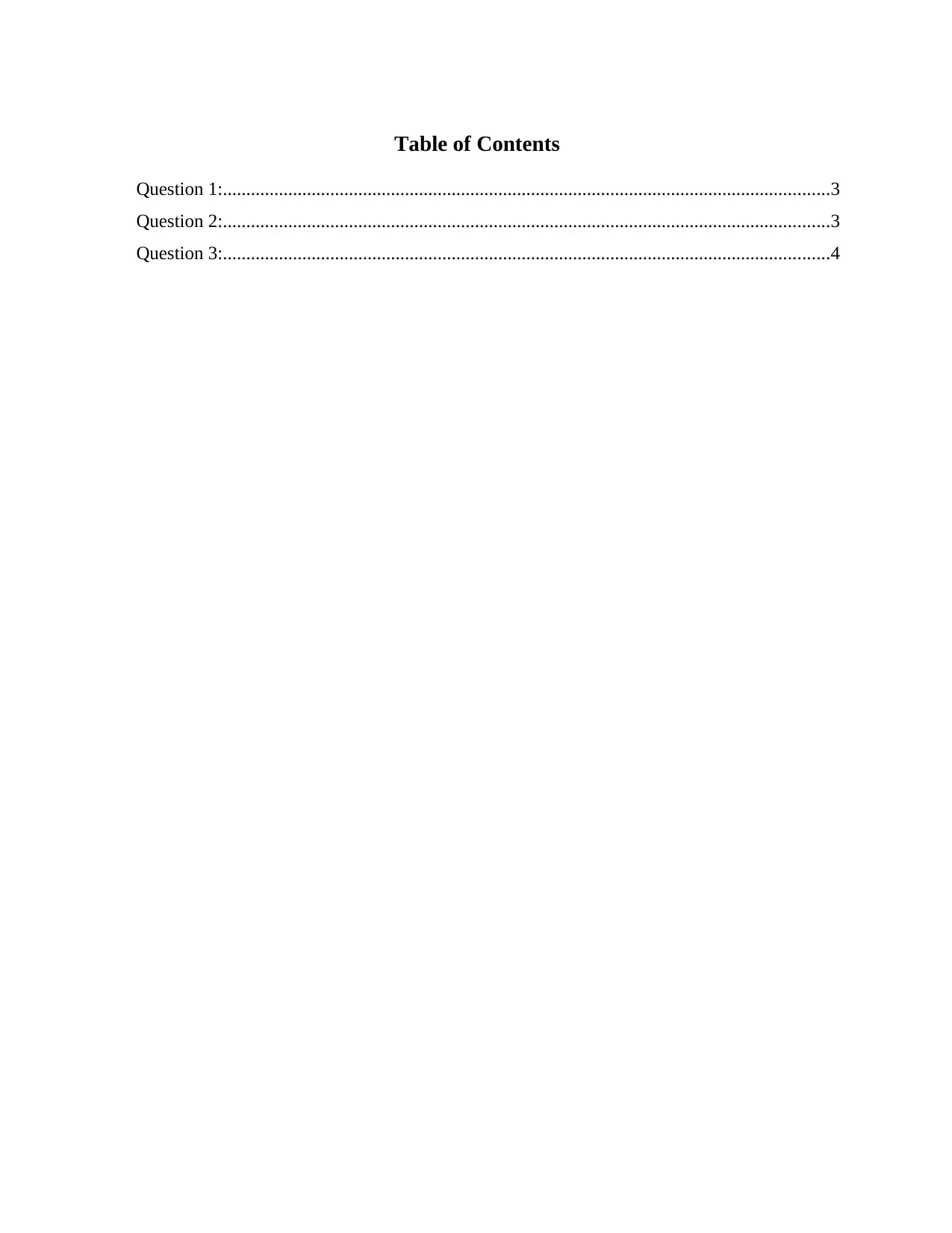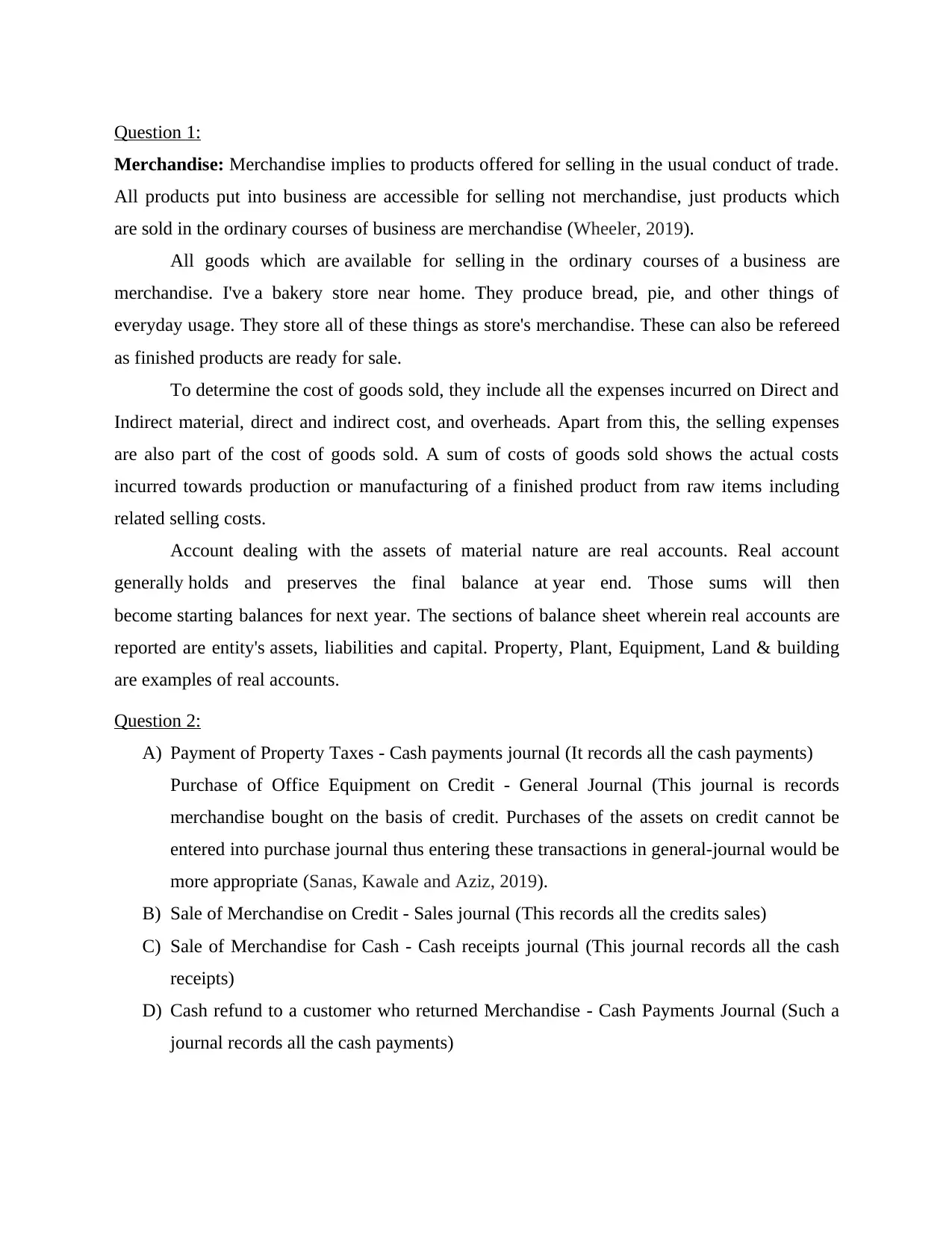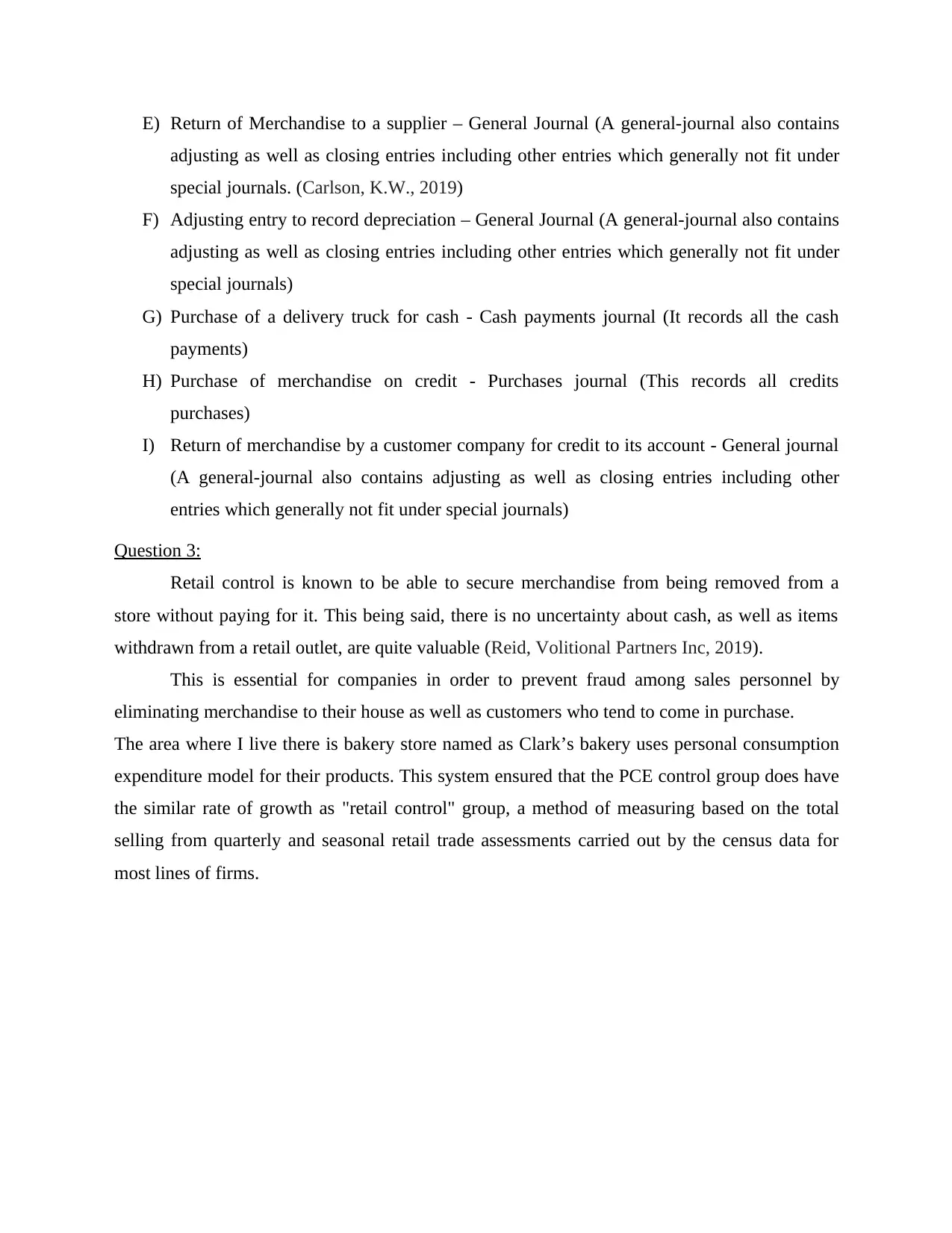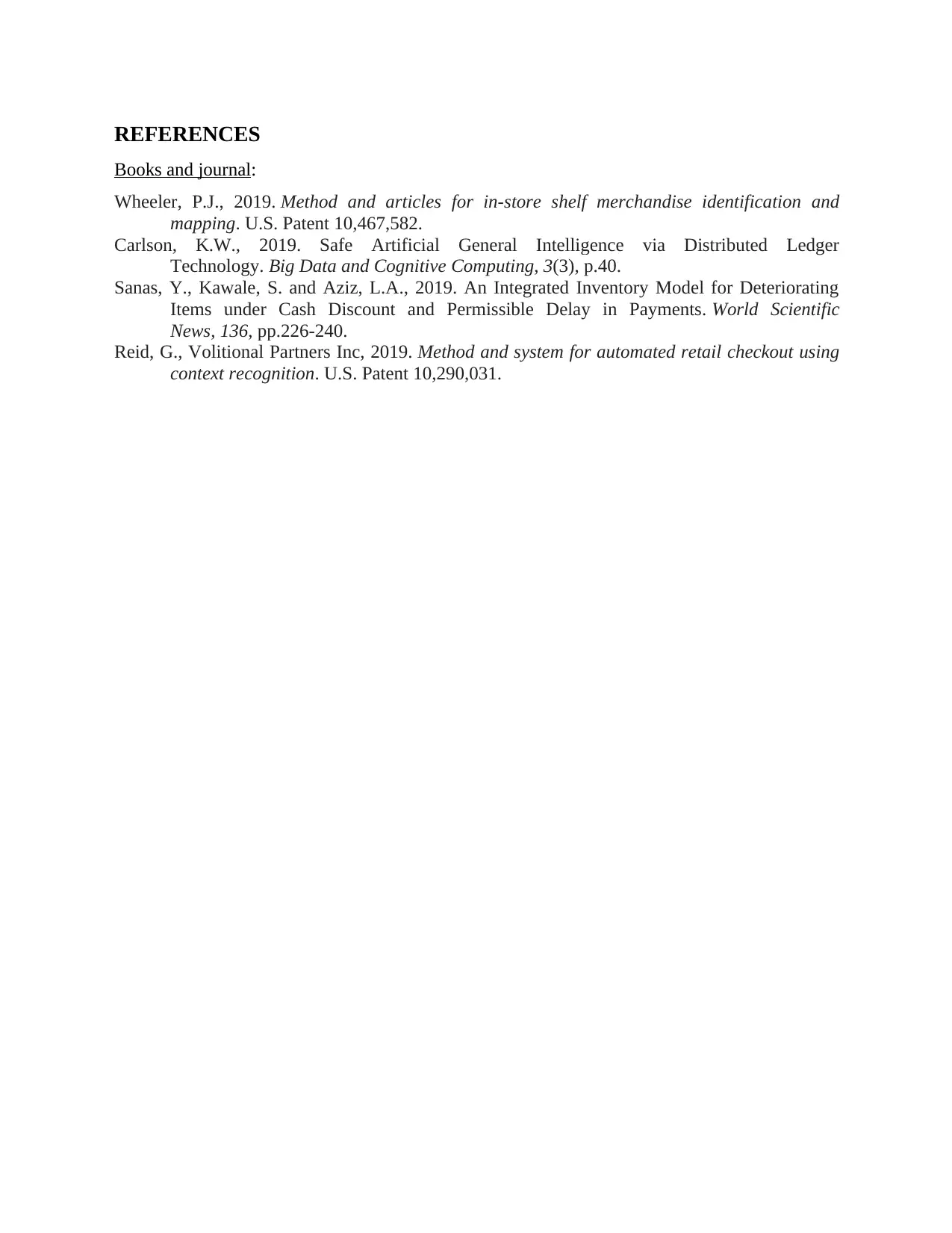Accounting Assignment: Journals and Retail Control
VerifiedAdded on 2023/01/09
|5
|840
|34
Homework Assignment
AI Summary
This document presents a comprehensive solution to an accounting assignment. Question 1 discusses merchandise, defining it as products sold in the ordinary course of business and explaining how a merchant determines the cost of goods sold, including direct and indirect costs, and overheads, and also describes real accounts with examples. Question 2 addresses journal entries, specifying which journal (cash receipts, cash payments, sales, purchases, or general journal) is used to record various transactions, such as property tax payments, equipment purchases, sales, and merchandise returns. Question 3 delves into retail control, emphasizing its importance in preventing theft and fraud, and provides an example of a bakery using a personal consumption expenditure model for control. The solution includes references to relevant academic sources.

Account
Paraphrase This Document
Need a fresh take? Get an instant paraphrase of this document with our AI Paraphraser

Table of Contents
Question 1:..................................................................................................................................3
Question 2:..................................................................................................................................3
Question 3:..................................................................................................................................4
Question 1:..................................................................................................................................3
Question 2:..................................................................................................................................3
Question 3:..................................................................................................................................4

Question 1:
Merchandise: Merchandise implies to products offered for selling in the usual conduct of trade.
All products put into business are accessible for selling not merchandise, just products which
are sold in the ordinary courses of business are merchandise (Wheeler, 2019).
All goods which are available for selling in the ordinary courses of a business are
merchandise. I've a bakery store near home. They produce bread, pie, and other things of
everyday usage. They store all of these things as store's merchandise. These can also be refereed
as finished products are ready for sale.
To determine the cost of goods sold, they include all the expenses incurred on Direct and
Indirect material, direct and indirect cost, and overheads. Apart from this, the selling expenses
are also part of the cost of goods sold. A sum of costs of goods sold shows the actual costs
incurred towards production or manufacturing of a finished product from raw items including
related selling costs.
Account dealing with the assets of material nature are real accounts. Real account
generally holds and preserves the final balance at year end. Those sums will then
become starting balances for next year. The sections of balance sheet wherein real accounts are
reported are entity's assets, liabilities and capital. Property, Plant, Equipment, Land & building
are examples of real accounts.
Question 2:
A) Payment of Property Taxes - Cash payments journal (It records all the cash payments)
Purchase of Office Equipment on Credit - General Journal (This journal is records
merchandise bought on the basis of credit. Purchases of the assets on credit cannot be
entered into purchase journal thus entering these transactions in general-journal would be
more appropriate (Sanas, Kawale and Aziz, 2019).
B) Sale of Merchandise on Credit - Sales journal (This records all the credits sales)
C) Sale of Merchandise for Cash - Cash receipts journal (This journal records all the cash
receipts)
D) Cash refund to a customer who returned Merchandise - Cash Payments Journal (Such a
journal records all the cash payments)
Merchandise: Merchandise implies to products offered for selling in the usual conduct of trade.
All products put into business are accessible for selling not merchandise, just products which
are sold in the ordinary courses of business are merchandise (Wheeler, 2019).
All goods which are available for selling in the ordinary courses of a business are
merchandise. I've a bakery store near home. They produce bread, pie, and other things of
everyday usage. They store all of these things as store's merchandise. These can also be refereed
as finished products are ready for sale.
To determine the cost of goods sold, they include all the expenses incurred on Direct and
Indirect material, direct and indirect cost, and overheads. Apart from this, the selling expenses
are also part of the cost of goods sold. A sum of costs of goods sold shows the actual costs
incurred towards production or manufacturing of a finished product from raw items including
related selling costs.
Account dealing with the assets of material nature are real accounts. Real account
generally holds and preserves the final balance at year end. Those sums will then
become starting balances for next year. The sections of balance sheet wherein real accounts are
reported are entity's assets, liabilities and capital. Property, Plant, Equipment, Land & building
are examples of real accounts.
Question 2:
A) Payment of Property Taxes - Cash payments journal (It records all the cash payments)
Purchase of Office Equipment on Credit - General Journal (This journal is records
merchandise bought on the basis of credit. Purchases of the assets on credit cannot be
entered into purchase journal thus entering these transactions in general-journal would be
more appropriate (Sanas, Kawale and Aziz, 2019).
B) Sale of Merchandise on Credit - Sales journal (This records all the credits sales)
C) Sale of Merchandise for Cash - Cash receipts journal (This journal records all the cash
receipts)
D) Cash refund to a customer who returned Merchandise - Cash Payments Journal (Such a
journal records all the cash payments)
⊘ This is a preview!⊘
Do you want full access?
Subscribe today to unlock all pages.

Trusted by 1+ million students worldwide

E) Return of Merchandise to a supplier – General Journal (A general-journal also contains
adjusting as well as closing entries including other entries which generally not fit under
special journals. (Carlson, K.W., 2019)
F) Adjusting entry to record depreciation – General Journal (A general-journal also contains
adjusting as well as closing entries including other entries which generally not fit under
special journals)
G) Purchase of a delivery truck for cash - Cash payments journal (It records all the cash
payments)
H) Purchase of merchandise on credit - Purchases journal (This records all credits
purchases)
I) Return of merchandise by a customer company for credit to its account - General journal
(A general-journal also contains adjusting as well as closing entries including other
entries which generally not fit under special journals)
Question 3:
Retail control is known to be able to secure merchandise from being removed from a
store without paying for it. This being said, there is no uncertainty about cash, as well as items
withdrawn from a retail outlet, are quite valuable (Reid, Volitional Partners Inc, 2019).
This is essential for companies in order to prevent fraud among sales personnel by
eliminating merchandise to their house as well as customers who tend to come in purchase.
The area where I live there is bakery store named as Clark’s bakery uses personal consumption
expenditure model for their products. This system ensured that the PCE control group does have
the similar rate of growth as "retail control" group, a method of measuring based on the total
selling from quarterly and seasonal retail trade assessments carried out by the census data for
most lines of firms.
adjusting as well as closing entries including other entries which generally not fit under
special journals. (Carlson, K.W., 2019)
F) Adjusting entry to record depreciation – General Journal (A general-journal also contains
adjusting as well as closing entries including other entries which generally not fit under
special journals)
G) Purchase of a delivery truck for cash - Cash payments journal (It records all the cash
payments)
H) Purchase of merchandise on credit - Purchases journal (This records all credits
purchases)
I) Return of merchandise by a customer company for credit to its account - General journal
(A general-journal also contains adjusting as well as closing entries including other
entries which generally not fit under special journals)
Question 3:
Retail control is known to be able to secure merchandise from being removed from a
store without paying for it. This being said, there is no uncertainty about cash, as well as items
withdrawn from a retail outlet, are quite valuable (Reid, Volitional Partners Inc, 2019).
This is essential for companies in order to prevent fraud among sales personnel by
eliminating merchandise to their house as well as customers who tend to come in purchase.
The area where I live there is bakery store named as Clark’s bakery uses personal consumption
expenditure model for their products. This system ensured that the PCE control group does have
the similar rate of growth as "retail control" group, a method of measuring based on the total
selling from quarterly and seasonal retail trade assessments carried out by the census data for
most lines of firms.
Paraphrase This Document
Need a fresh take? Get an instant paraphrase of this document with our AI Paraphraser

REFERENCES
Books and journal:
Wheeler, P.J., 2019. Method and articles for in-store shelf merchandise identification and
mapping. U.S. Patent 10,467,582.
Carlson, K.W., 2019. Safe Artificial General Intelligence via Distributed Ledger
Technology. Big Data and Cognitive Computing, 3(3), p.40.
Sanas, Y., Kawale, S. and Aziz, L.A., 2019. An Integrated Inventory Model for Deteriorating
Items under Cash Discount and Permissible Delay in Payments. World Scientific
News, 136, pp.226-240.
Reid, G., Volitional Partners Inc, 2019. Method and system for automated retail checkout using
context recognition. U.S. Patent 10,290,031.
Books and journal:
Wheeler, P.J., 2019. Method and articles for in-store shelf merchandise identification and
mapping. U.S. Patent 10,467,582.
Carlson, K.W., 2019. Safe Artificial General Intelligence via Distributed Ledger
Technology. Big Data and Cognitive Computing, 3(3), p.40.
Sanas, Y., Kawale, S. and Aziz, L.A., 2019. An Integrated Inventory Model for Deteriorating
Items under Cash Discount and Permissible Delay in Payments. World Scientific
News, 136, pp.226-240.
Reid, G., Volitional Partners Inc, 2019. Method and system for automated retail checkout using
context recognition. U.S. Patent 10,290,031.
1 out of 5
Related Documents
Your All-in-One AI-Powered Toolkit for Academic Success.
+13062052269
info@desklib.com
Available 24*7 on WhatsApp / Email
![[object Object]](/_next/static/media/star-bottom.7253800d.svg)
Unlock your academic potential
Copyright © 2020–2025 A2Z Services. All Rights Reserved. Developed and managed by ZUCOL.




